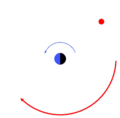Retrograde and direct motion facts for kids
When we talk about how planets and moons move, we often use terms like direct motion and retrograde motion. Direct motion, also called prograde motion, is when a planet or moon moves in the same direction as most other objects in its solar system. Think of it like cars on a racetrack all going the same way.
Retrograde motion is the opposite. It means an object is moving in the direction opposite to the main flow. For some space objects, like the moons in the Carme group around Jupiter, this backward movement is real. They actually orbit or spin in the opposite direction compared to their planet.
Contents
Why Planets Seem to Go Backward
Sometimes, a planet in our sky might look like it's changing direction and moving backward for a short time. It creates a kind of "loop" or "squiggle" in its path before going back to normal. This is called apparent retrograde motion because it only seems to happen. The planet isn't actually moving backward.
This strange effect happens because Earth is also moving! We see it when outer planets, like Mars or Jupiter, are near a point called opposition. Opposition is when Earth is directly between the Sun and that outer planet.
Understanding Apparent Motion with Cars
Imagine two cars driving on two different circular tracks that are next to each other. One car is on the inner track, and the other is on the outer track. Both cars are going the same speed.
The car on the inner track will finish its circle faster because it has a shorter distance to travel. From the point of view of the driver in the inner car, the car on the outer track will seem to fall behind, even though both are moving at the same speed. It will look like the outer car is moving slower or even going backward for a moment.
This is similar to how apparent retrograde motion works for planets. As Earth (the inner car) overtakes an outer planet (the outer car) in its orbit, the outer planet appears to move backward against the background of distant stars.
Images for kids
See also
 In Spanish: Movimientos retrógrado y prógrado para niños
In Spanish: Movimientos retrógrado y prógrado para niños



